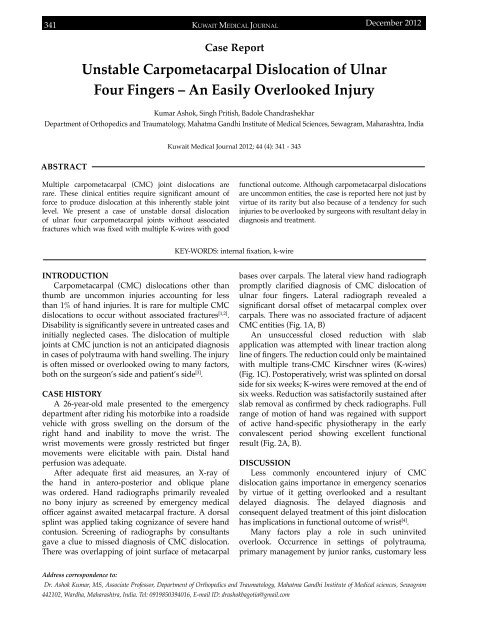Vol 44 # 4 December 2012 - Kma.org.kw
Vol 44 # 4 December 2012 - Kma.org.kw
Vol 44 # 4 December 2012 - Kma.org.kw
Create successful ePaper yourself
Turn your PDF publications into a flip-book with our unique Google optimized e-Paper software.
341<br />
KUWAIT MEDICAL JOURNAL<br />
<strong>December</strong> <strong>2012</strong><br />
Case Report<br />
Unstable Carpometacarpal Dislocation of Ulnar<br />
Four Fingers – An Easily Overlooked Injury<br />
Kumar Ashok, Singh Pritish, Badole Chandrashekhar<br />
Department of Orthopedics and Traumatology, Mahatma Gandhi Institute of Medical Sciences, Sewagram, Maharashtra, India<br />
Kuwait Medical Journal <strong>2012</strong>; <strong>44</strong> (4): 341 - 343<br />
ABSTRACT<br />
Multiple carpometacarpal (CMC) joint dislocations are<br />
rare. These clinical entities require significant amount of<br />
force to produce dislocation at this inherently stable joint<br />
level. We present a case of unstable dorsal dislocation<br />
of ulnar four carpometacarpal joints without associated<br />
fractures which was fixed with multiple K-wires with good<br />
functional outcome. Although carpometacarpal dislocations<br />
are uncommon entities, the case is reported here not just by<br />
virtue of its rarity but also because of a tendency for such<br />
injuries to be overlooked by surgeons with resultant delay in<br />
diagnosis and treatment.<br />
KEY-WORDS: internal fixation, k-wire<br />
INTRODUCTION<br />
Carpometacarpal (CMC) dislocations other than<br />
thumb are uncommon injuries accounting for less<br />
than 1% of hand injuries. It is rare for multiple CMC<br />
dislocations to occur without associated fractures [1,2] .<br />
Disability is significantly severe in untreated cases and<br />
initially neglected cases. The dislocation of multiple<br />
joints at CMC junction is not an anticipated diagnosis<br />
in cases of polytrauma with hand swelling. The injury<br />
is often missed or overlooked owing to many factors,<br />
both on the surgeon’s side and patient’s side [3] .<br />
CASE HISTORY<br />
A 26-year-old male presented to the emergency<br />
department after riding his motorbike into a roadside<br />
vehicle with gross swelling on the dorsum of the<br />
right hand and inability to move the wrist. The<br />
wrist movements were grossly restricted but finger<br />
movements were elicitable with pain. Distal hand<br />
perfusion was adequate.<br />
After adequate first aid measures, an X-ray of<br />
the hand in antero-posterior and oblique plane<br />
was ordered. Hand radiographs primarily revealed<br />
no bony injury as screened by emergency medical<br />
officer against awaited metacarpal fracture. A dorsal<br />
splint was applied taking cognizance of severe hand<br />
contusion. Screening of radiographs by consultants<br />
gave a clue to missed diagnosis of CMC dislocation.<br />
There was overlapping of joint surface of metacarpal<br />
bases over carpals. The lateral view hand radiograph<br />
promptly clarified diagnosis of CMC dislocation of<br />
ulnar four fingers. Lateral radiograph revealed a<br />
significant dorsal offset of metacarpal complex over<br />
carpals. There was no associated fracture of adjacent<br />
CMC entities (Fig. 1A, B)<br />
An unsuccessful closed reduction with slab<br />
application was attempted with linear traction along<br />
line of fingers. The reduction could only be maintained<br />
with multiple trans-CMC Kirschner wires (K-wires)<br />
(Fig. 1C). Postoperatively, wrist was splinted on dorsal<br />
side for six weeks; K-wires were removed at the end of<br />
six weeks. Reduction was satisfactorily sustained after<br />
slab removal as confirmed by check radiographs. Full<br />
range of motion of hand was regained with support<br />
of active hand-specific physiotherapy in the early<br />
convalescent period showing excellent functional<br />
result (Fig. 2A, B).<br />
DISCUSSION<br />
Less commonly encountered injury of CMC<br />
dislocation gains importance in emergency scenarios<br />
by virtue of it getting overlooked and a resultant<br />
delayed diagnosis. The delayed diagnosis and<br />
consequent delayed treatment of this joint dislocation<br />
has implications in functional outcome of wrist [4] .<br />
Many factors play a role in such uninvited<br />
overlook. Occurrence in settings of polytrauma,<br />
primary management by junior ranks, customary less<br />
Address correspondence to:<br />
Dr. Ashok Kumar, MS, Associate Professor, Department of Orthopedics and Traumatology, Mahatma Gandhi Institute of Medical sciences, Sewagram<br />
<strong>44</strong>2102, Wardha, Maharashtra, India. Tel: 0919850394016, E-mail ID: drashokbagotia@gmail.com
















